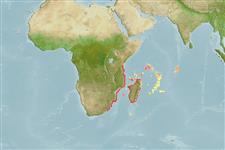Elasmobranchii (tubarões e raias) (sharks and rays) >
Carcharhiniformes (Ground sharks) >
Scyliorhinidae (Cat sharks)
Etymology: Holohalaelurus: Greek 'Holos' meaning entire, referring to the lack of labial folds, and the genus Halaelurus, for which Holohalaelurus was proposed as a subgenus of by Fowler (1934).; punctatus: Name most likely derived from Latin 'punctum' meaning small hole, dot or spot, referring to the many small spots covering the dorsal surface of this species (Ref. 75585).
Ambiente / Clima / Intervalo
Ecologia
; marinhas batidemersal; intervalo de profundidade 220 - 440 m (Ref. 5510). Deep-water, preferred ?; 4°S - 37°S
Western Indian Ocean: endemic to the subtropical and tropical waters of southwestern Indian Ocean, southern Mozambique, off Natal, South Africa and off Madagascar (Ref. 75585).
Status of threat: a common catch in bottom trawls in Natal and southern Mozambique, yet, despite recent biodiversity trawl surveys in that region, not a single specimen has been collected from this area since 1972. ORI data sheets confirm that specimens collected between 1964 and 1972 were apparently abundant, particularly off Mozambique in May 1969, and off Durban in June 1971. The only specimens of this species that have been collected since this date have been those from Madagascar in the late 1980’s and early 1990’s (Ref. 75585).
Length at first maturity / Tamanho / Peso / Idade
Maturity: Lm ?, range 30 - 32.6 cm
Max length : 35.0 cm TL macho/indeterminado; (Ref. 5510); 26.0 cm TL (female)
Descrição breve
Morfologia | Morfometria
Espinhos dorsais (total): 0; Raios dorsais moles (total): 0; Espinhos anais 0; Raios anais moles: 0. A broad-headed, dwarf catshark with small dark brown spots closely set on a yellow-brown or orange-brown background; small black pores on underside of head and body; no labial furrows (Ref. 5578).
Found on the uppermost continental slopes (Ref. 244). Feeds on small fishes, crustaceans, and cephalopods (Ref. 5213). The adult males are larger than females, a characteristic unusual among sharks (Ref. 244). Manifests partial sexual segregation. Oviparous (Ref. 50449).
Life cycle and mating behavior
Maturidade | Reprodução | Desova | Ovos | Fecundidade | Larvas
Oviparous, with one egg-case laid per oviduct at a time. Embryos feed solely on yolk (Ref. 50449). Partial sexual segregation is manifested by greater number of males than females off Natal but not off southern Mozambique.
Compagno, L.J.V., 1984. FAO Species Catalogue. Vol. 4. Sharks of the world. An annotated and illustrated catalogue of shark species known to date. Part 2 - Carcharhiniformes. FAO Fish. Synop. 125(4/2):251-655. Rome: FAO. (Ref. 244)
Categoria na Lista Vermelha da IUCN (Ref. 115185)
CITES (Ref. 94142)
Not Evaluated
Ameaça para o homem
Harmless
Utilização humana
Pescarias: sem interesse
Mais informação
Idade/TamanhoCrescimentoComprimento-pesoComprimento-comprimentoFrequência de comprimentoMorfometriaMorfologiaLarvasDinâmica larvarRecrutamentoAbundância
ReferênciasAquaculturaPerfil para aquaculturaEstirpesGenéticaFrequência dos alelosHereditariedadeDoençasProcessamentoMass conversion
ColaboradoresFotografiasStamps, CoinsSonsCiguateraVelocidadeTipo de nataçãoÁrea branquialOutras referênciasCérebrosVisão
Ferramentas
Relatórios especiais
Descarregue XML
Fontes da internet
